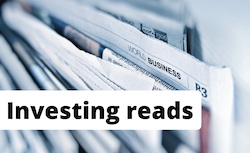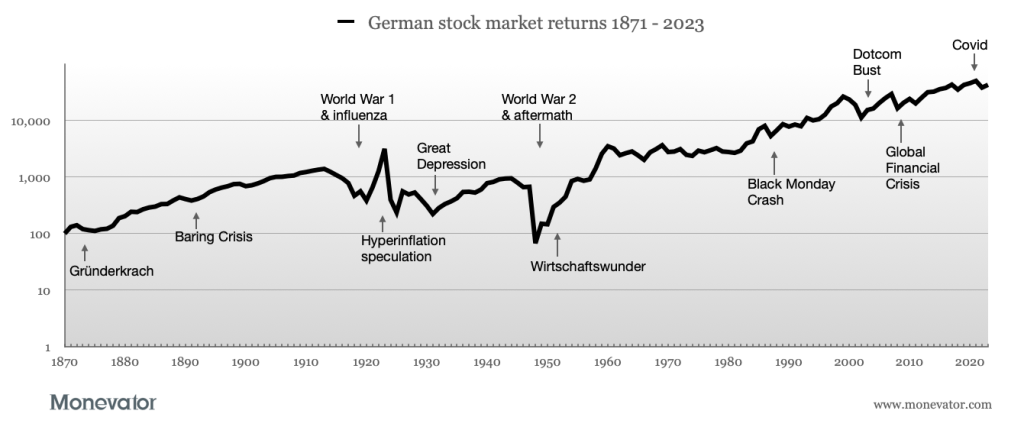
Sometimes you just need a little bit of inspiration. A template that you can adapt and make your own. That’s what these investment portfolio examples provide.
I’ve chosen them because each offers a different perspective on asset allocation that you can customise to suit your personal financial objectives, circumstances, and temperament.
The truth is there is no one portfolio to rule them all. Whichever load-out ‘won’ the last decade or three is unlikely to top the podium in the future.
Instead of dwelling on yesterday’s winners, this selection of model investment portfolios enables you to answer the question: “what does a rational, diversified asset allocation look like?”
The trick is to pick one that chimes with your attitude to risk, time horizon, and tolerance for complexity. From there, you can mould it around your situation as you gain in confidence and experience.
As ever we’ve created our investment portfolio examples with ETFs and index funds because we believe that a passive investing strategy is the best investment approach for most people.
We’ve also included shortcuts with each to a comparable portfolio on the low-cost InvestEngine platform, as an illustration.1
Note these are affiliate links. InvestEngine is currently offering a £25 welcome bonus when you sign up using our link. Also, if you set up a savings plan to regularly autoinvest with InvestEngine before 31 August, you’ll be in with a chance of winning £1,000 (Ts&Cs apply). You don’t have to sign up to see the investment portfolio examples. Remember that when investing, your capital is at risk.
Okay, let’s get stuck in!
Harry Markowitz Portfolio
Asset class
Index tracker
OCF
50% Developed world
Amundi Prime Global ETF (PRWU)
0.05%
50% Medium bonds
Invesco UK Gilts (GLTA)
0.06%
This easy-as-it-gets portfolio is based on the tale of how the father of Modern Portfolio Theory solved his own asset allocation dilemma. Unable to decide, Harry Markowitz simply split his money 50/50 between the two most important asset classes: equities and government bonds.
The Markowitz portfolio is particular suitable for first-timers who don’t know how they’ll react to market volatility. A 50% equity allocation is conservative enough that you’re unlikely to be frightened off shares for life if you’re whacked by a big crash early on.
Later, you can adjust your allocation in line with your risk tolerance when you know better how well you cope with turbulence.
From here, you can easily move up the gears to a classic 60/40 portfolio, or even more gung-ho allocations if you discover you’d sell your grandmother to buy more shares in a market meltdown.
Whatever you decide, investing doesn’t have to be more complicated than this. Developed World equities offer ample stock market diversification and growth potential, while government bonds are the keystone defensive asset class.
See the Harry Markowitz portfolio at InvestEngine.
Lost in translation
Stateside writers typically recommend US stocks and government bonds. For UK investors this better translates to Developed World equities and gilts. For even greater diversification you can substitute global equities and global government bonds hedged to the pound. You’ll find trackers that fulfill that brief below. Finally, when we say bonds, we always mean government bonds with one exception: the total bond fund in the Income Investing Portfolio includes some corporate debt.
David Swensen’s Ivy League Portfolio
Asset class
Index tracker
OCF
30% Developed world
Amundi Prime Global ETF (PRWU)
0.05%
15% UK equities
Vanguard FTSE UK All Share2
0.6%
5% Emerging markets
Amundi Prime Emerging Markets ETF (PRAM)
0.1%
20% Global property
Amundi ETF FTSE EPRA/NAREIT Global ETF (EPRA)
0.24%
15% Medium bonds
Invesco UK Gilts (GLTA)
0.06%
15% Short global index-linked bonds
Lyxor Core Global Inflation-Linked 1-10Y Bond ETF (GISG)
0.22%
The famed Yale endowment fund manager came up with this portfolio for passive investors in his superb investing book Unconventional Success.3
Swensen’s model investment portfolio is much better diversified than Markowitz’s but that doesn’t always work to your advantage. UK equities, emerging markets, and property have endured a tough 15 years or so versus the developed world.
Perhaps that trend will mean revert – but there are no guarantees.
Also notice the common portfolio trope of splitting your bond allocation 50/50 between nominal bonds and their index-linked cousins. The nominals typically do better in a recession but get battered by soaring inflation. Meanwhile index-linked bonds have anti-inflation features built in.
Finally, 15% in UK equities looks chunky now our home stock market represents less than 5% of global market capitalisation. You could just as well decide to reallocate an extra 10% to developed world equities, and keep just 5% in Blighty.
See the David Swensen Portfolio at InvestEngine.
Tim Hale Smarter Portfolio: global
Asset class
ETF name
OCF
27% Developed world
Amundi Prime Global ETF (PRWU)
0.05%
21% Global multifactor
iShares Edge MSCI World Multifactor (FSWD)
0.5%
6% Emerging markets
Amundi Prime Emerging Markets ETF (PRAM)
0.1%
6% Global property
Amundi ETF FTSE EPRA/NAREIT Global ETF (EPRA)
0.24%
20% Medium global bonds £ hedged
Amundi Index JP Morgan GBI Global Govies (GOVG)
0.15%
20% Short global index-linked bonds
Lyxor Core Global Inflation-Linked 1-10Y Bond ETF (GISG)
0.22%
This portfolio is adapted from the British wealth manager’s excellent UK-focussed investment book, Smarter Investing.
The standout feature is the global multi-factor allocation, which nods to Hale’s belief in the value and small cap risk factors. These amount to informed bets on particular types of high-risk stocks that have historically outperformed the broader market over the long-run.
Hale’s tilt to the risk factors is grounded in strong evidence but it also comes with an advisory health warning. That’s because they’ve underperformed a straightforward developed world tracker for well over a decade now.
Perhaps patience will prove a virtue. But it’s worth remembering that the market can make a mockery of the best ideas. Moreover, the supposed benefits of complexity often prove illusory and there is nothing wrong with keeping things simple.
See the Tim Hale Global Portfolio at InvestEngine.
Harry Browne’s Permanent Portfolio
Asset class
Index tracker
OCF
25% Developed world
Amundi Prime Global ETF (PRWU)
0.05%
25% Long bonds
Vanguard UK Long-Duration Gilt4
0.12%
25% Gold
Amundi Physical Gold (GLDA)
0.11%
25% Cash
Lyxor Smart Overnight Return (CSH2)
0.07%
The Permanent Portfolio does something very different from the other investment portfolio examples. It deliberately underweights equities and focuses on suppressing the volatility that makes conventional portfolios such a rollercoaster.
That’s achieved via the large allocations to long bonds, gold, and cash. They guard your flanks against a panoply of economic threats:
Long bonds and cash ward off deflation and recessions.
Gold is meant to withstand high and unexpected inflation (although its record in this respect is patchy).
Equities are your growth engine as usual.
The Permanent Portfolio has a well-established track record and historically it has protected investors from the worst slumps (relative to conventional asset allocations).
That’s because the assets enjoy low correlations – they tend to behave quite differently from each other, so can cover for each other’s weaknesses – and also because the portfolio allocates an uncommonly small percentage to equities.
But the price you pay is lower expected long-term returns because the portfolio’s growth engine is under-powered.
That makes the Permanent Portfolio best suited to wealth preservers and the acutely risk-averse.
Note, we’ve used a money market fund in place of cash, but high-interest savings accounts will do just as nicely.
See the Permanent Portfolio at InvestEngine.
Ray Dalio All Weather Portfolio
Asset class
Index tracker
OCF
30% Developed world
Amundi Prime Global ETF (PRWU)
0.05%
40% Long bonds
SPDR Bloomberg Barclays 15+ Year Gilt (GLTL)
0.15%
15% Medium bonds
Invesco UK Gilts (GLTA)
0.06%
7.5% Broad commodities
UBS CMCI Composite SF (UC15)
0.34%
7.5% Gold
Amundi Physical Gold (GLDA)
0.11%
The All Weather portfolio is another of the investment portfolio examples that prioritises stability over booming returns.
Conceived by the Bridgewater hedge fund founder, Ray Dalio, it’s an evolution of Harry Browne’s insight: choose a carefully balanced set of uncorrelated assets so that something should always be working in your portfolio, regardless of the economic conditions.
The inclusion of commodities is the most notable difference.
Commodities are a strong diversifier that offer decent long-term returns and act as a partial inflation hedge. But they can also spend years underwater, so don’t invest in them without doing your research.
Long bonds are similarly a great equity diversifier and not for the faint-hearted. They’re particularly vulnerable when inflation and rising interest rates bite. Dig into these pieces on bond durations, yields, and prices for the lowdown.
Inflation-repelling index-linked bonds are an obvious All Weather addition, but they’re not officially featured. Personally I’d add a slug by paring back the long bond allocation.
Overall, this is another wealth-preservation portfolio, but only if you can see past the individual performances of its components.
The All Weather combines an extremely volatile mix of asset classes that gel because they should counterbalance each other over time.
The obverse is something in this portfolio will almost always be causing you pain. So you have to be able to view the portfolio holistically, or else you’ll resent it like carrying around a big umbrella on a sunny day.
See the Ray Dalio All Weather Portfolio at InvestEngine.
A decumulator’s ‘Ready For Anything’ Portfolio
Asset class
Index tracker
OCF
60% Global equities
HSBC FTSE All-World Index Fund C5
0.13%
10% Medium bonds
Invesco UK Gilts (GLTA)
0.06%
10% Short global index-linked bonds
Lyxor Core Global Inflation-Linked 1-10Y Bond ETF (GISG)
0.2%
10% Broad commodities
UBS CMCI Composite SF (UC15)
0.34%
10% Cash
Lyxor Smart Overnight Return (CSH2)
0.07%
This is my own take on a diversified portfolio suitable for an early retiree who needs a strong equity allocation to achieve their sustainable withdrawal rate. The diversifiers are chosen to diminish the threat of sequence of returns risk.
The medium-term bonds defend against downturns, without the eye-bleed inflation risk of their longer-dated cousins.
Broad commodities and index-linked bonds do their best to deal with the inflation monster. We’ve previously explained why we’d plump for global inflation-linked bond trackers over their UK equivalents.
Cash is there as an all-round workhorse providing for immediate liquidity and moderate recession protection. It’s also less vulnerable to inflation than medium bonds.
Potential tweaks? If you’re a fan of gold then you could swap it in for half or all of the portfolio’s broad commodities exposure.
See the Decumulation Portfolio at InvestEngine.
Income Investing Portfolio
Asset class
Index tracker
OCF
50% Global high yield
Vanguard FTSE All World High Dividend (VHYG)
0.29%
20% UK high yield
Vanguard FTSE UK Equity Income6
0.14%
30% Total global bonds
Amundi Index Global Aggregate 500M (AGHG)
0.08%
Income investing is a popular retirement strategy that swerves the risk of running out of money by leaving your capital untouched. Living expenses are funded purely from dividends and interest.
It sounds wonderful but the downside is you need a very large portfolio to generate enough income, even if you choose high-yielding dividend funds – as we’ve done for this load-out.
See the Income Investing Portfolio at InvestEngine.
The SUV Portfolio
Asset class
Index tracker
OCF
15% UK equities
Vanguard FTSE UK All Share7
0.06%
15% Developed world ex UK
Vanguard FTSE Dev World ex-UK Equity8
0.14%
10% Property
iShares UK Property ETF (IUKP)
0.4%
30% Short global index-linked bonds
Lyxor Core Global Inflation-Linked 1-10Y Bond ETF (GISG)
0.22%
30% Short bonds
L&G UK Gilt 0-5 Year ETF (UKG5)
0.06%
Another of my creations, this 60% bond-weighted portfolio downgrades volatile equities in favour of the greater crash protection of fixed income.
Your portfolio could sensibly look something like this if you’re at or near-retirement. Essentially, you’ve hit your number, won the game, and don’t need to take big risks with your wealth anymore.
A solid slug in equities still offers some growth however, while the enlarged UK position reduces currency risk.
Also notice the short bond selection that acts more like cash and limits the portfolio’s susceptibility to inflation and rising interest rates.
The trade-off is short bonds don’t bounce as high as medium- or long-term bonds when stocks cave in.
See the SUV Portfolio at InvestEngine.
Investment portfolio examples: key takeaways
An important principle underlying the investment portfolio examples is that there’s more than one way to cut the cake.
A retiree relying on their portfolio to pay the bills for the rest of their life has very different needs to a 20-something investor who can make good capital losses with pay rises to come.
Even then, while it’s commonly assumed young people can afford to take big and hairy investing risks, that entirely depends on an individual’s ability to remain calm when their stocks are being shredded by the market wood-chipper. In reality, not everyone sees that as the buying opportunity of a lifetime.
Meanwhile the investment psychology of a retiree living off a chunky defined benefits pension who’s managing an investment portfolio for fun money and legacy may have more in common with 100% equity flyboys than a normal decumulator.
So take the time to think about who you are and what you’re trying to achieve. If you don’t know yet, then the Markowitz portfolio is a great place to start.
Beyond that, we’ve tried to keep our investment portfolio example’s manageable. No more than six funds max. But note that the miracle of capitalism means you can actually diversify perfectly well with a single product, if you choose a multi-asset fund.
Please note that these investment portfolio examples are not investment advice, a recommendation, or an inducement to buy or sell financial instruments. If you’re unsure of the risk or suitability of an investment, seek advice from an independent financial adviser.
Build upon the basics
When considering your plan, remember that each asset class should play a strategic role in your portfolio.
In the broadest terms that means:
Global equities for growth grunt
Nominal government bonds protect against recessions and crashes
Index-linked bonds step in when unexpected inflation runs riot
Commodities and gold provide some inflation protection, but are really held to guard against scenarios when equities and bonds face-plant simultaneously
Fees matter so our product picks are typically the lowest-cost index funds or ETFs available.
That isn’t to say you can’t do better. Here are thoughts on how you might go about selecting:
The best global tracker funds
The best bond funds
Commodity ETFs
Prepare to go live
If you’re struggling to push the button and finally invest for real, fear not. It happened to me and many better investors besides. You are not alone.
Focus on the right process and you won’t go far wrong:
Sign up to a low-cost investing platform
Automate your investing
Drip-feed your money into the market
Use your tax shelters
Rebalance your holdings to control risk
Take less risk as you get older or have achieved your objectives. Don’t get greedy!
Learn how to manage your investment portfolio
I wish you the very best of luck. I well remember the flutters of excitement and nerves that accompanied my first jump off the investing diving board.
Investing has changed my life for the better and I sincerely hope it does the same for you.
Finally if you’re a Monevator veteran for whom these investment portfolio examples have been more a familiar ramble than wide-eyed adventure, then why not forward this article to a friend or family member who needs to get started?
Take it steady,
The Accumulator
Note: InvestEngine (UK) Limited is Authorised and Regulated by the Financial Conduct Authority, [FRN 801128].
Equivalent index trackers are chosen when InvestEngine doesn’t stock the article’s suggested fund.GB00B3X7QG63Swensen’s original US version featured 30% domestic equities and 15% developed world. That makes sense if you’re American because the US stock market is well-diversified. UK investors should flip these allocations around.GB00B4M89245GB00BMJJJF91GB00B59G4H82GB00B3X7QG63GB00B59G4Q73
The post Investment portfolio examples: asset allocation models for beginners appeared first on Monevator.



